- within Criminal Law, Law Practice Management, Litigation and Mediation & Arbitration topic(s)
As organisations navigate dramatic transformations in response to shifts in technology, workforce expectations, and business dynamics, reward strategies often lag behind wider organisational changes. A company's strategy and culture should be mirrored in its reward systems. The term of 'alignment' is used ubiquitously in this context. Yet frequently, we see a disconnect between how an organisation defines itself and the message its reward arrangements send to its workforce and the wider talent market.
The need for alignment is not new
Aligning reward strategy with organisational culture and business strategy is imperative for driving engagement, performance, and overall business success. A '101-principle' of reward design. When employees see a clear connection between their rewards and the organisation's values and strategic goals, they are more likely to feel valued, motivated, and aligned with the company's mission. This alignment fosters a sense of purpose and belonging, enhancing job satisfaction and retention.

However, failing to align reward strategies can lead to significant cost and detrimental impact. A misaligned reward strategy can result in several negative effects such as:
- Confusion and frustration among employees, leading to disengagement, high turnover rates, and the risk of a toxic workplace culture.
- The misallocation of resources, where employees are incentivised to pursue goals that do not align with the organisation's strategic objectives, ultimately hindering business performance.
- Inconsistent reward practices can damage the organisation's reputation, making it difficult to attract top talent and potentially leading to legal and compliance risks if perceived as unfair or discriminatory.
Therefore, ensuring that reward strategies reflect and reinforce the organisational culture and business strategy is not just a best practice, but a critical component of sustainable business success.
So, when the stakes are so high, why do so many organisations miss the mark?
This paper explores the imperative of tailoring your reward strategy to align with your unique organisational context and talent needs, drawing out the issue through four organisational archetypes: Innovators, Legacy Operators, High-Growth Startups, and Purpose-Driven Entities.
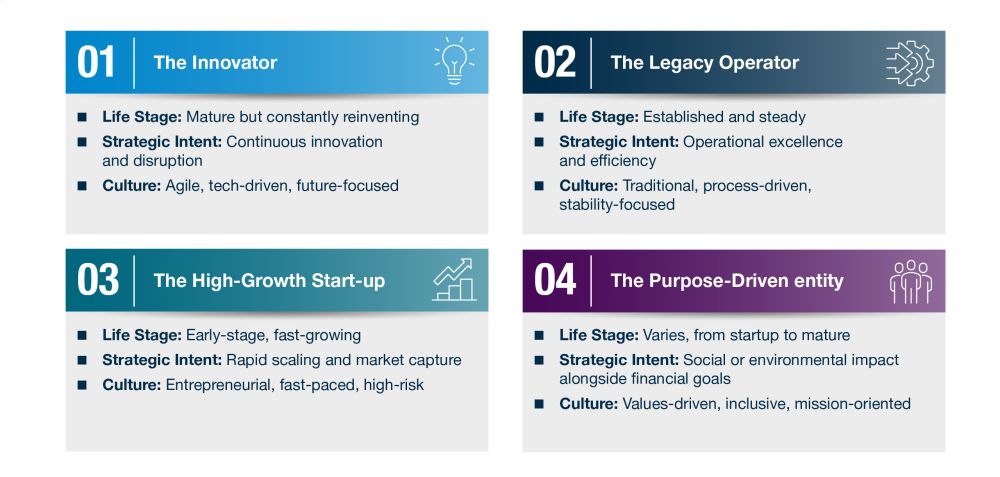

Summary: Innovators are companies that thrive on creativity, technological advancement, and market disruption. These organisations prioritise reinvention and agility, fostering a culture where employees are encouraged to take risks and think outside the box. The Innovator organisation rewards innovation to encourage a culture where risk-taking and creativity are valued; crucial for organisations that depend on constant innovation to stay competitive.
Reward philosophy – key themes:
- Innovation-driven rewards: Rewards are structured to encourage risk-taking and creativity, which are critical for maintaining a competitive edge in fast-moving markets.
- Long-term alignment: Emphasis on aligning rewards with long-term goals to foster sustained growth and reduce turnover.
- Flexibility and autonomy: Providing a flexible work environment that promotes work-life balance, leading to higher job satisfaction and productivity.
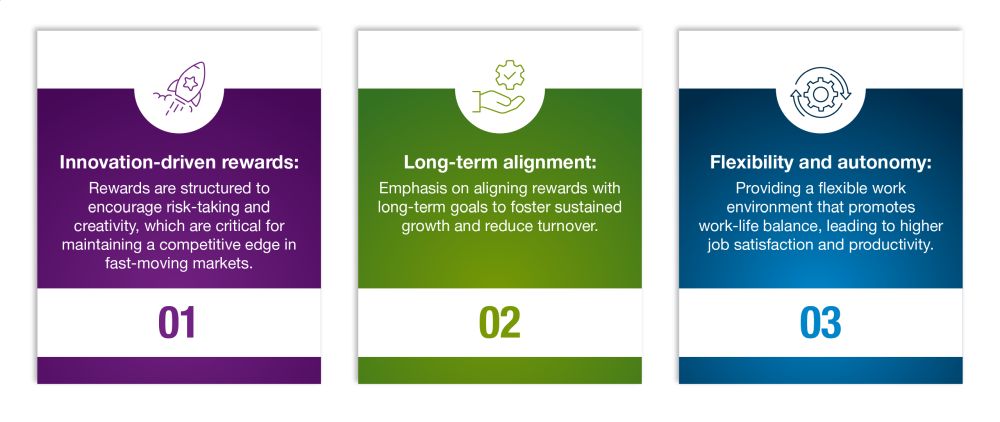
Reward Strategy:
Innovators need to incentivise creativity, agility, and risk-taking. This goes beyond financial rewards, incorporating intrinsic motivators like autonomy, mastery, and purpose. Key components include:
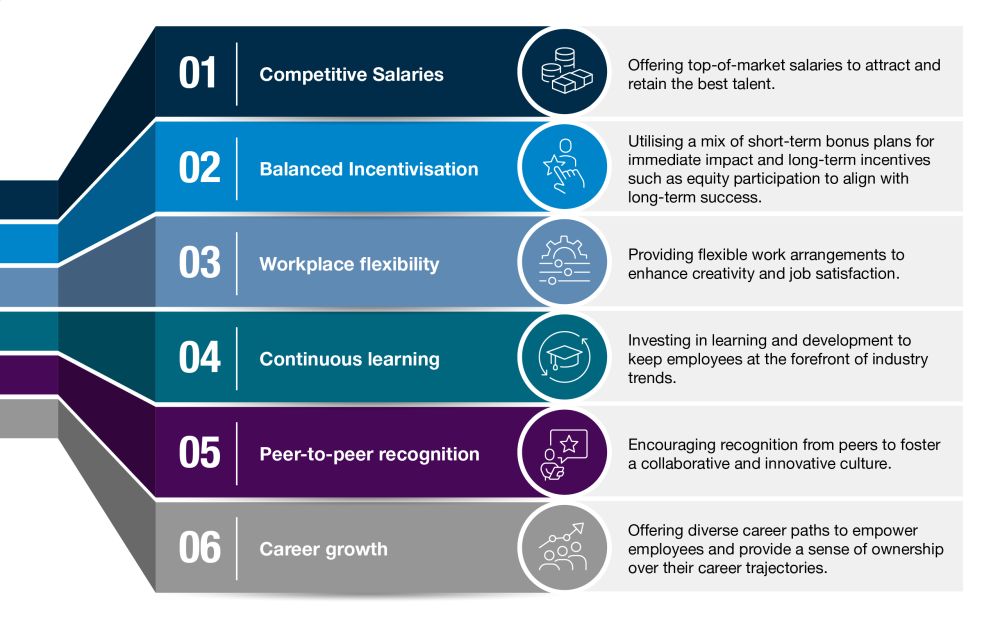
Key benefits: For Innovators, a reward strategy that prioritises innovation, flexibility, and long-term alignment is crucial to sustaining a culture of creativity and continuous growth. By incentivising risk-taking, offering competitive financial rewards, and supporting work-life balance, Innovator organisations can attract and retain top talent who thrive in dynamic, forward-thinking environments. A well-crafted reward strategy becomes a critical enabler, allowing these organisations to maintain their competitive edge in rapidly evolving markets.

Summary: Legacy Operators are well-established companies that prioritise stability, operational excellence, and efficiency. These organisations value predictability and process adherence, often with a significant portion of their workforce being long-tenured employees.
Reward philosophy – key themes:
- Long-term commitment: Rewards are designed to recognise and reinforce long-term loyalty and contribution.
- Security and stability: Benefits and rewards are predictable and transparent, ensuring trust and consistency.
- Operational excellence: Emphasis on performance against operational targets and adherence to process-driven goals.
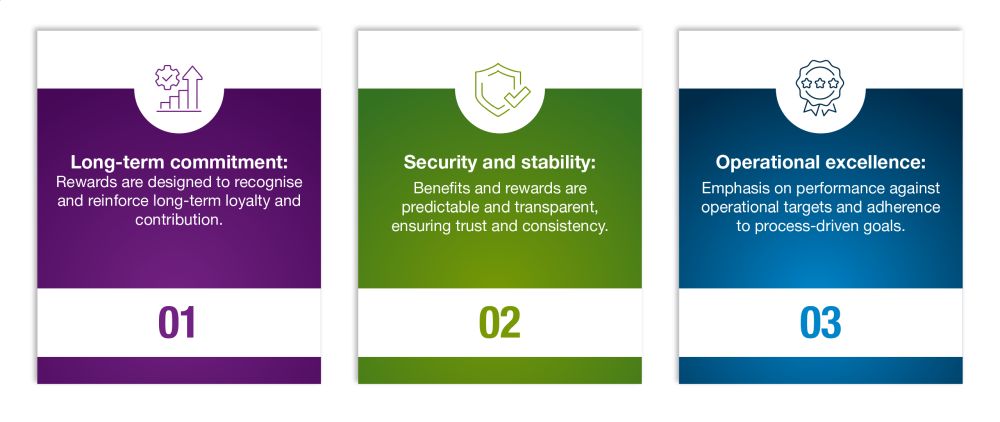
Reward strategy:
Legacy Operators thrive on stability and predictability. Their reward structures are built on 'responsible reward' principles that reinforce loyalty and consistency. Key components include:
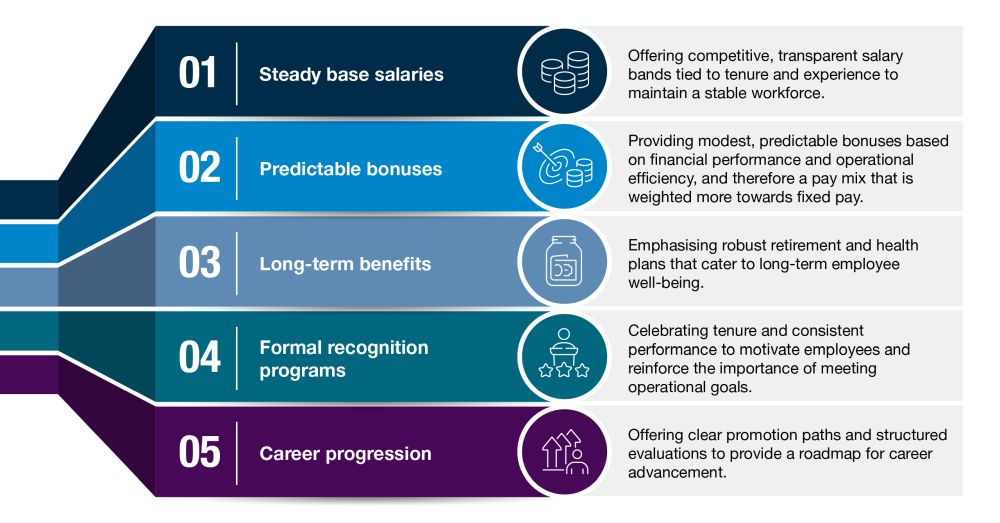
Key benefits: Legacy Operators benefit from a reward strategy that emphasises stability, loyalty, and operational excellence. By focusing on predictable rewards, long-term benefits, and clear career pathways, these organisations can maintain a dedicated workforce that values security and consistency. Tailoring the reward strategy to reflect these priorities ensures that long-tenured employees remain engaged and committed, which is essential for sustaining operational efficiency and market leadership.

Summary: High-Growth Startups are characterised by rapid expansion and a focus on speed, innovation, and bold decision-making. Employees are typically ambitious and entrepreneurial, motivated by growth and wealth creation.
Reward philosophy – key themes:
- Wealth creation and growth: Attracting talent willing to take risks for high potential rewards.
- Speed and agility: Encouraging quick decision-making and adaptability.
- Ownership and autonomy: Empowering employees to feel a sense of ownership and make meaningful contributions.
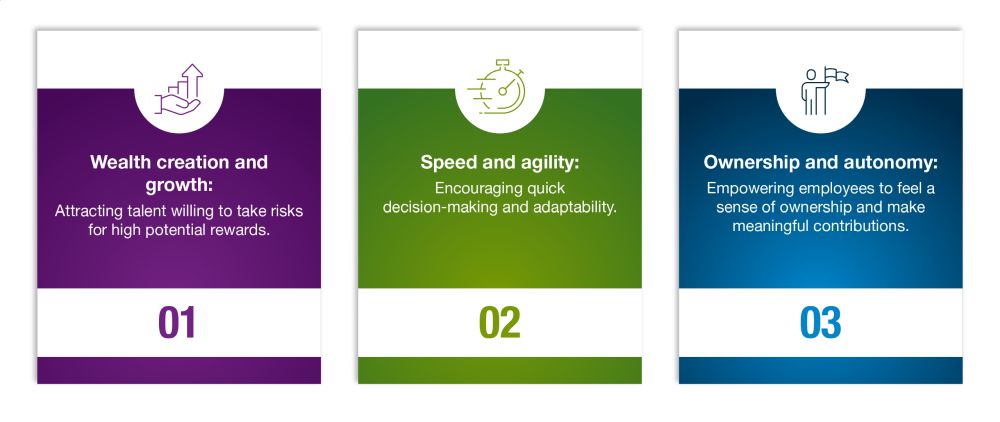
Reward strategy:
Startups need a reward strategy that emphasises equity and long-term wealth creation, appealing to those driven by growth and innovation. Key components include:
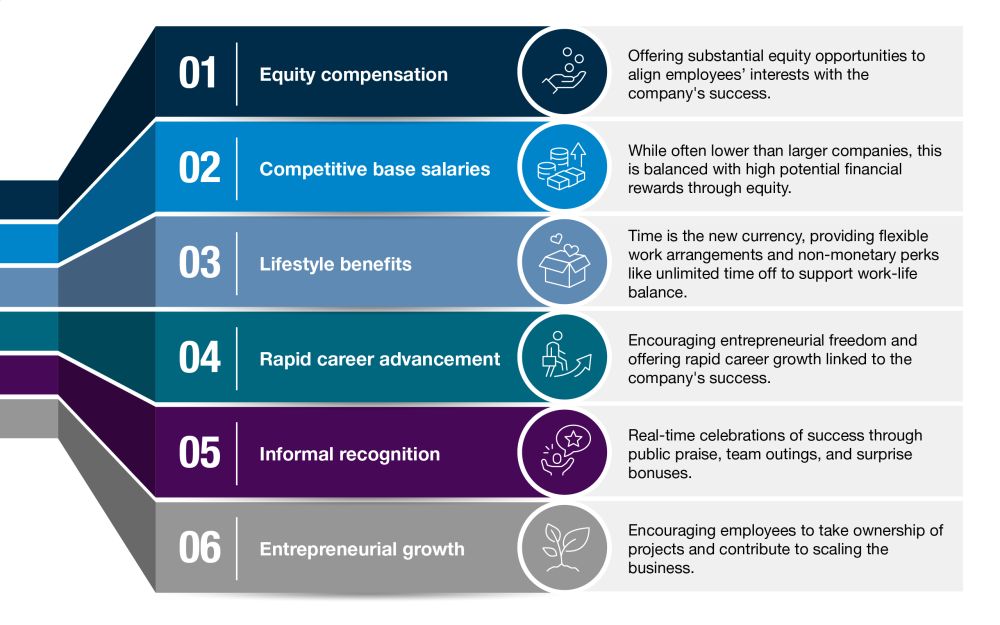
Key benefits: High-Growth Startups thrive on speed, agility, and the promise of future success, making equity and entrepreneurial opportunities key components of their reward strategy. By offering substantial long-term incentives and flexible work arrangements, these startups can attract ambitious, risk-taking individuals who are motivated by the potential for significant financial rewards and career growth. A tailored reward approach enables startups to build a motivated, innovative team that can drive rapid scaling and market disruption.

Summary: Purpose-Driven Entities focus on making a positive social or environmental impact. Employees are motivated by a sense of purpose and aligning their work with personal values.
Reward philosophy – key themes:
- Alignment with mission: Rewards are tied to achieving social, environmental, or community impact goals.
- Transparency and equity: Prioritising fair pay and benefits to ensure a fair and inclusive environment.
- Well-being and engagement: Supporting employees in both their work and personal lives to promote overall well-being.
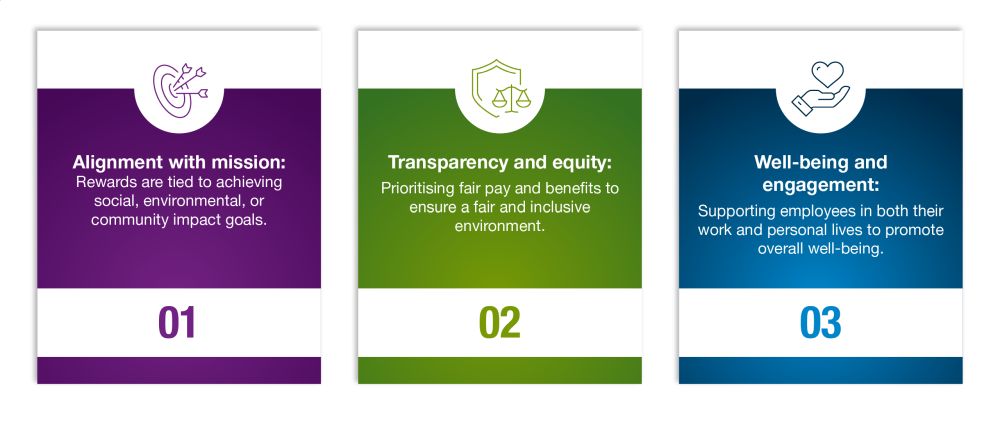
Reward strategy: Purpose-Driven Entities align rewards with their mission, focusing on impact, inclusivity, and personal well-being. Key components include:

Key benefits: For Purpose-Driven Entities, a reward strategy that aligns with their mission and values is paramount. By focusing on equitable pay, mission-linked incentives, and benefits that support well-being and inclusivity, these organisations can attract and retain employees who are passionate about making a positive impact. A reward strategy that reflects the organisation's commitment to relevant social and/or environmental goals not only enhances employee engagement but also reinforces the organisation's identity and purpose.
Conclusion: The imperative of tailored reward strategies
In a world of constant and rapid change and transformation, a one-size-fits-all approach to reward strategy is no longer sufficient. While the archetypes discussed - Innovators, Legacy Operators, High-Growth Startups, and Purpose-Driven Entities - provide clear examples of how organisational identity and strategic goals can shape reward strategies, it is crucial to acknowledge that not all organisations will fit neatly into one of these categories. Many organisations will find themselves straddling multiple archetypes or evolving from one to another over time. The archetypes serve as illustrative examples to highlight the broader principle: the critical need for customised reward strategies that are as unique as the organisations they serve.
Furthermore, this article has intentionally stayed silent on the debate around the personalisation of rewards to capture nuanced, individual workforce needs. While personalising rewards can further enhance employee engagement and satisfaction, our focus here is on the broader organisational alignment of reward strategies. Understanding the strategic and cultural context of the organisation itself is a foundational step before diving into individual personalisation.
As organisations look to tailor their reward strategies, several key considerations and challenges must be addressed:

By recognising these considerations and challenges, organisations can more effectively tailor their reward strategies to align with their unique needs and strategic objectives. The reward strategy becomes a living embodiment of the organisation's DNA, reinforcing its unique identity and purpose. When crafted with precision and intentionality, a customised reward strategy not only aligns with but also amplifies an organisation's strategic vision and cultural fabric, turning reward into a strategic lever that drives sustained competitive advantage. As organisations navigate the complexities of the modern workplace, the ability to tailor reward strategies to their specific context will be a defining factor in their success. Now, more than ever, the need for bespoke reward strategies is not just a strategic choice - it's an essential business imperative for success.
Originally published by 02 October, 2024
The content of this article is intended to provide a general guide to the subject matter. Specialist advice should be sought about your specific circumstances.


